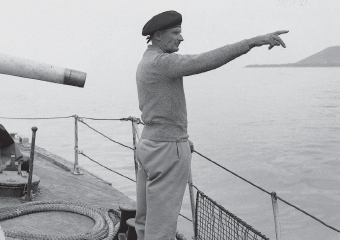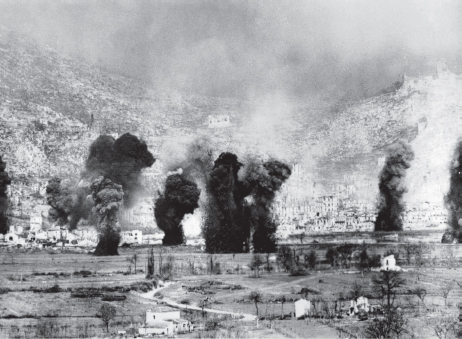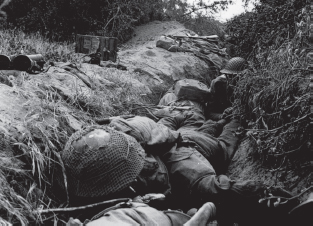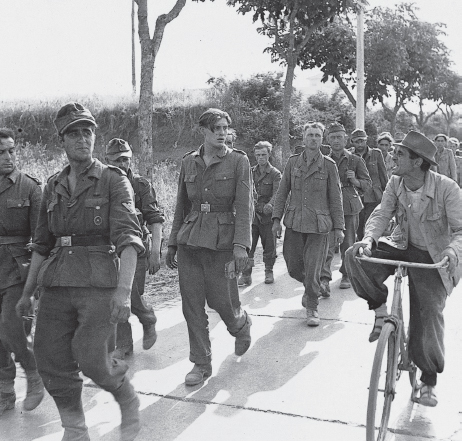
Полная версия
Whicker’s War and Journey of a Lifetime

During our serene sessions on the terrace of the Casa Cuseni we even had time to take silly shots for home consumption of ourselves larking about – ‘red-hots’, we called them.
I can’t remember the reason for such warriors’ relaxation. The photographs were taken in the morning, so demon vino was no excuse. Why then do grown men behave in such a way? I think we should be told.
I suspect dear old Alfred Black may have instigated the pictorial fooling around; son of George Black, the impresario who ran the Palladium and other theatres in London and Blackpool, he probably directed our light-hearted romps. The pictures were taken, I suspect, for the lovely Roma Beaumont, one of Ivor Novello’s leading ladies from The Dancing Years and such, who was also Alf’s wife. This was the only occasion I can recall during the war when we had the time or the taste for jolly frolics.
More seriously, we considered future picture-coverage of the war on the Italian mainland, which was going to mean splitting our Unit. First it had to be decided whether Captain Harry Rignold or I should lead our cameramen across the Straits at Réggio Calabria to cover the Eighth Army’s opening assault upon Italy.
The other would return to Africa to join the more militarily significant operation Buttress, the landing a week later up the coast near Salerno by the new and American-controlled Fifth Army. That bay, thirty-five miles south of Naples, was at the extreme limit of our vital air cover.
Rignold, my senior, had the choice of course. We had spent some days together driving and filming through central Sicily, and I had come to like and much admire him. Small and soft-spoken, he was a most unmilitary figure, but brave and eager. He had caught the excitement of an assault landing while filming at Narvik in Norway, May 1940. That landing was a combined operation and, like Dieppe, a considerable defeat – but for Harry a splendid photo opportunity. So he chose Salerno, the bigger story – and was killed on the beach. I went across the Straits of Messina with the 2nd Inniskilling Fusiliers – the ferocious ‘Skins’ – and landed safely. I had drawn another lucky card.
Taormina had been too good to last. Very soon we were reminded there was a war to be won, and our serenity each twilight had been a sort of mirage.
So we dispersed and set off to fight once again. Harry Rignold left for Africa with his cameramen, and on the evening of September 3 ’43 my sergeants and I boarded our LCIs in Catania docks. We were back at war as a sort of decoy invasion, hoping to lure German divisions down south and away from the coming Salerno landing.
As we settled in, the massed invasion fleet due to sail that night was attacked by German fighter-bombers. So much, we thought, for surprise. They already had the unwelcome mat out…
On the fourth anniversary of Britain’s entry into the war we sailed from the comforting shores of Sicily, where by now we felt we were at home among friends. The fleet assembled off the coast, and at dawn our silent armada approached the dark mountains and narrow beaches of Italy’s toe.
The Straits of Messina are less than three miles wide. Should we get into any trouble, I felt we could swim across, backwards or forwards. We were to land along a five-mile stretch of beach north of Réggio. It reminded me of our invasion of Sicily, but through a golden mist across a smoother sea. Already I was feeling like an assured veteran: been there, invaded that…
During our peaceful days in Taormina the Royal Artillery had drawn up all its biggest guns around Messina and now set about pinpointing and silencing any enemy batteries across the Straits.
As we neared our landing beach the massed gunners behind us used up the Royal Artillery’s Sicilian reserves of ammunition, supported by the rocket-firing devil-ships which were sailing alongside us. These were landing craft packed with launchers firing 800 five-inch rockets in 30 seconds. Each contained 301b of TNT. They tore open the sky with an insane howling madness that filled all men – friends and foe – with shock and fear.
There was no reply from the enemy artillery – and it was easy to understand why! Some shells crashed around us into the sea. They were ours, falling short – but even so, were not welcome. Friendly fire can hurt just as much. Still no answer from the enemy coast.
At 5.30am we hit the beach and ran inland to escape any German fire. It did not arrive. The Luftwaffe flew in to strafe and bomb, but otherwise the Eighth Army once again walked ashore almost unopposed. It seemed in the last few days the Wehrmacht had withdrawn to man its next defensive line across Italy – or perhaps had picked-up warning Intelligence about the coming landing at Salerno. We had fired 400 tons of HE at empty hillsides.
Encouraged by the absence of resistance, Driver Talbot and I set off to chase the enemy inland – but cautiously. We drove past huge Italian coastal guns near Pellaro, also made by Vickers in 1930, also unmanned. It was like a holiday drive, through lovely scenery.
Then, rounding a bend in the mountain road, we were confronted by an approaching column of a couple of hundred Italian soldiers bound for the invasion beach, all belligerently armed and evidently ready to resist our attack upon their homeland.
As Talbot froze in horror, it dawned upon me that my .38 Smith and Wesson revolver – our only armament – was still beneath my reissued kit at the bottom of my new kitbag. My old kitbag was still at the bottom of the Med. I was not a fearsome figure.
In that instant I realised, with regret, that I had been thinking too much about pictures when war is for fighting. In a film unit preoccupied with observation, it was all too easy to fall into the role of detached spectator – you can’t shoot me, Jerry, I’m just watching – when everyone else has taken sides and is trying to kill you.
At OCTU back in Barmouth I had absorbed the military dictum that Attack is the Best Form of Defence, so I leapt smartly from the jeep, using strong language and brandishing my camera. It was, at that moment, all I had to brandish.
To my surprise it was most effective. No one shot me – indeed, the massed Italians were delighted. Guns were put down, combs appeared, buttons done up, and the whole troop gathered around me manoeuvring for position, flashing eager smiles and showing their best sides for the picture. Look at me, Ma, I’m surrendering!
They were all going home, they told me, for the war was over between our nations and peace had been declared. This was quite inaccurate but at 200 to 2, I was not about to argue. Anything that made them happy was all right by me. I took loads of pictures and warmly commended them to our nearest fighting unit just a few miles down the road, regretting that I was unable to accept prisoners – or even co-belligerents – however amiable. In my experience this is not a ploy that works with the German Army.
During the whole jolly surrender I was earnestly hoping that the successful and invasion-happy Eighth Army would not suddenly come bursting around the corner in our footsteps, all guns blazing. Fortunately it was too far behind.
We parted with mutual expressions of relief and regard. Their eager surrender to the following infantry was, unfortunately, a little premature. Italy did not capitulate for another five days during which they all went, not home but towards the start of a journey to a POW camp in Africa, as its final prisoners.
They didn’t even get their prints. I still feel rather guilty about that…
VERY BAD JOKES INDEED…

After our peaceful, almost gentlemanly invasion of Réggio Calabria, the Eighth Army advanced 100 miles in five days. It was the only week in the whole Italian campaign that could be described as Easy. Afterwards the Germans, the terrain and the weather combined against us.
Hoping not to attract any more would-be prisoners, Talbot and I drove north up the big toe of Italy. Just past the coastal bunion at Vibo Valéntia, we took over a house in the small town of Nicastro – and there made a new friend.
He was a small brown mongrel with large appealing eyes who instantly grew accustomed to our faces, and our army rations. By the time we were ready to move on towards Cosenza, we had become inseparable and he was part of AFPU, keeping an eye on things. He rode between us in the jeep, bright and alert, answering to his new and natural name: Nic. Pleasant to have a dog about the place – makes you feel more like a family.
We three set out one bright clear morning, planning to go as far north as we could, until the Germans reacted. After an hour or so we picked a sunny spot for lunch, and lay around enjoying the calm and the scenery. Then suddenly across the valley behind us we saw a familiar threatening scene approaching, fast: a convoy of RASC trucks following our road to the front and throwing up the usual dense dust-clouds.
This was the torment of all unsurfaced country roads in summer. Find yourself off-tarmac and amid traffic and within minutes your jeep and you would be a living statue, thick-coated by a pea-souper of choking dust.
Panic! We had to get away before the convoy arrived or we should be eating their dust and driving slowly through their clouds for hours.
We slung the remains of our picnic into the back of the jeep, along with ration boxes and everything we had unloaded for the siesta. We got moving as the first truck rounded the nearby bend, trailing its white cloud and heading implacably towards us. I gunned the jeep and we sailed away, just in front of the choking clouds. Phew.
We easily out-ran the convoy and were alert also to the survival warning of the Army’s inescapable sign: Dust Brings Shells. It must have been an hour later when I was hunting through the disordered jeep for my maps when we suddenly remembered … Where’s Nic?
In the frenzy to get away through clear air, we had left the poor little chap finishing his lunch … and about to be engulfed in a maelstrom of trucks and noise and dust.
We waited for the convoy to pass, then for their dust to settle, then drove back to hunt around our picnic location, calling his name. No echo of that cheerful bark. No wagging tail, no excited recognition. Perhaps he had struck off across country towards Nicastro for the unexpired portion of his day’s rations? Perhaps he had been picked up by someone in that convoy? Stricken, we never risked our affections again. Goodbye Nic, young Italian charmer lost in action.
Heading on through the mountains, we paused to relieve an internment camp, full of civilians of various nationalities. You would think detainees who had been imprisoned for many months would have been delighted to see Allies in liberating-mode, riding to their rescue? Not a bit of it.
Their guards had run away, and now some 50 of Mussolini’s prisoners, having raided the camp kitchen, were enjoying a family picnic under the trees. They were a well-dressed group lazing around in a scene of contentment.
Then some of the younger male detainees took me aside and mentioned that by freeing them I was not doing them any favours: they’d had a cushy billet with regular meals and no worries, living a peaceful country life with other friendly families, many of whom had pretty young daughters. They were quite content to escape wartime worries outside the wire, with nothing to do all day except lie around in the long grass and be charming. Furthermore, their sex lives had never been so good.
Unamused, I offered to lock them up again and throw away the key. On reflection they reluctantly decided to accept the worrisome freedom I had thrust upon them. Their cheerful group did contrive to make my war seem rather pointless.
I left them to their bucolic pursuits and got back on the road north, chasing reality. This soon became all too apparent when on the west coast of Italy three Allied Divisions of the Fifth Army steamed in from Africa and attempted a landing near Salerno – to face the most savage resistance of the war, led by the 16th Panzer Division.
Another easy landing had been expected after the dismissal of Mussolini and Italy’s surrender, but this was no longer the musical-comedy bella figura battle – just going through the motions – that the Italians had undertaken without the equipment or the will to fight. These were fierce and determined counter-attacks by crack German divisions which had been expecting – even rehearsing for – our landing. The Fifth Army, exposed and vulnerable, seemed about to be destroyed before even gaining a toehold on Italy.
AFPU had four officers and eleven sergeant-cameramen covering this different sort of assault landing. As they sailed in, one landing craft was hit by 20 enemy shells. Others exploded as they struck mines or were strafed by the Luftwaffe squadrons which were out in strength. In the chaos some craft put in to wrong beaches. The precise invasion timetable disintegrated.
Sergeant R.P. Lambert, our smallest photographer, was in an LCI heading for the beach, standing behind a tall infantryman of the Queen’s Regiment. The tense silence was broken when a soldier leaned down and whispered, ‘If that guy steps into the sea and disappears, Sarge, you ain’t half gonna get wet.’
Such a cheery routine exactly followed those morale-boosting war movies. From officers came similar flip Ealing comedy throwaways about seeing Naples and dying. These soon proved to be very bad jokes indeed.
Harry Rignold, my opposite number, had landed from an LCI and was moving across the beach when a shell burst in the sand in front of his jeep. His right hand was blown off. Sergeant Penman and their driver were also injured.
Harry walked calmly to the sea wall, carrying his camera in his remaining hand. Putting it down carefully he said, ‘I’m going to the RAP to get my arm fixed.’
He was lying on a stretcher at the regimental aid post awaiting evacuation by ship when another shell fell amid the wounded and killed that gentle and excellent man. He died without knowing he had been awarded the Military Cross.

The Italians’ coastal defence guns (made in Britain) could have done our invasion great damage – had they been manned by grown-ups …

General Montgomery landed in Reggio in an amphibious DUKW instead of his usual Humber, to be greeted by pipers of the 51st Highland Division.

When he saw a camera Monty would always point at something, in a most commanding way.

I went with him for his first meeting with General Mark Clark, whose Fifth Army had landed behind enemy lines. The beleaguered Clark welcomes Monty to his Beachhead.

Monty goes to explain to Clark and his Chief-of-Staff Major General Gruenther how the Eighth Army will help the Fifth. (His Officer-in-Attendance is the regulation two paces behind).

The Americans did not receive the usual Liberation-welcome in Naples, where the population was still stunned by bombing and German destruction.

My opposite number in AFPU, the brave and gentle Captain Harry Rignold, was killed during the landing on Salerno beach.

For months the German positions holding up our advance around Monte Cassino resisted all Allied attacks …

… despite powerful support by artillery, from 4.2” mortars, and up…

… and by Sherman Tanks …

… so finally 239 Flying Fortresses flew in to destroy the Benedictine Monastery which had stood amid the wild peaks of the Abruzzi for 1,400 years.

Some of the 453½ tons of bombs that fell on Cassino in the first aerial attack.

The ancient citadel of art and learning, after the bombing.

After our triumphant assault landing at Anzio, this was as close to Rome as we got for almost five months: the Flyover. Later, when the Germans launched three major attacks to throw us back into the sea, this was as far as they got.

Infantrymen under attack in the wadis. Even a small ditch seemed secure and reassuring.

A German view of the battle, as they occupied their side of the Flyover.

An enemy 15cm armoured Infantry Howitzer in firing position amid the ruins of Carroceto.

Captured American troops are marched through Rome, under armed guard.

Other German soldiers are less dominant. Held at gunpoint after capture by New Zealand troops during the Battle of Cassino.

On the road to Rome an Italian cyclist voices his opinion of the German Army – by then safely disarmed and marching to the stockade.

Taking pictures in a POW camp, one face seemed to me to symbolize the end of Teutonic dreams of conquest. I called this portrait ‘The Master Race’. Next to that tragic figure, a young German POW appreciated that, for him at least, the war was over.
Along the beach Sergeant J. Huggett had also just got ashore. Ahead of him some Commandos were holding a small promontory against heavy German counter-attacks. Huggett, tall and game, set off up the hill to get pictures of the action. Near the top an angry voice ordered, ‘This way! This way!’ It was the Commando officer.
‘You took your bloody time, Sergeant,’ he shouted. ‘Where the hell are your men?’ Huggett admitted that he had come alone, to get pictures. ‘What?’ cried the officer, after an emotional silence, ‘I called for reinforcements, not a fucking photographer.’
One understands exactly how he felt; there are times when you just don’t want your picture taken – even though it may well be your last…
The Luftwaffe flew in close-support for Kesselring’s 15 divisions; for the first time we were outnumbered and clinging-on desperately. After two days the landing was going so badly that the Allied Commander, the American General Mark Clark, prepared plans for re-embarkation. He seemed ready to pack up and go home. His Army had only one escape route – by sea. It was unnerving to learn that our own Commander had even considered running back to the ships and sailing away.
He was eventually discouraged by tougher minds among senior American and British officers like Rear Admiral Tom Troubridge who could see that an attempted re-embarkation on beaches dominated by German artillery in the overlooking hills would be a massacre. They bullied and finally persuaded him against the possibility of retreat, but for indecisive days the Allies faced their first major defeat.
The crisis on the beaches followed a flawed invasion plan drawn up by inexperienced officers in which two of our three assault divisions had been given defensive missions. The third, the 46th Division, carried the lone offensive role – but was landed too far from Salerno for its execution. The result was a desperate battle to establish the beachhead by three separate and un-cooperating forces. There was also a seven-mile gap between our X Corps and the US VI Corps. No wonder General Clark despaired.
Back at AFHQ Eisenhower had heard that his friend was planning re-embarkation, and worried that he might have lost his nerve. He told his USN ADC that Clark should show the spirit of a naval Captain and if necessary, go down with his ship. This seemed unlikely.
One echo of the desperation on the beaches survives in Salerno today: in a tidy but little-visited monumental garden in town stands a very small memorial. You need to crouch down to read its inscription. Few passers-by would notice its anguished cry – the thoughts and reactions of the men of the American 45th Infantry Division which put ashore two regimental combat teams under Major General Troy Middleton. Their scorn and bitterness is conveyed by two quotations inscribed on this stone, this memory of desperation.
General Mark Clark US Fifth Army Commander: ‘Prepare to evacuate the beach.’ Underneath, the words of his subordinate, Major General Middleton: ‘Leave the water and the ammo on the beach. The 45th Division is here to stay.’
It is rare indeed for a division to castigate publicly its Army Commander for considering sailing away from the battle. Rarer still, President Roosevelt later awarded Clark the Distinguished Service Cross for gallantry at Salerno.
Lieutenant General Mark W. Clark – Wayne to his friends – graduated from West Point in 1917, 109th in a class of 135, and was afterwards a Captain for 16 years. His career took-off with the war and the friendship of General Eisenhower, with whom he shared an apartment in London. At 46 he became the youngest Lieutenant General the US Army had ever known, with a passion for publicity already well established. As Fifth Army Commander in Italy he refused to stay in the Royal Palace in Naples, explaining humbly to the Press that he felt lost in a big city. He had been raised in Chicago.
Caserta, 30 miles to the north, was the Allied forces headquarters during the war. This enormous mid-18th century palace had been built by the Bourbon King Charles IV to outdo Versailles, but General Clark still found no suitable accommodation within its 1200 rooms, so set up a trailer, a converted truck, in the formal gardens behind the Palace – which as he explained in resultant publicity, was no place for an American cowboy.






